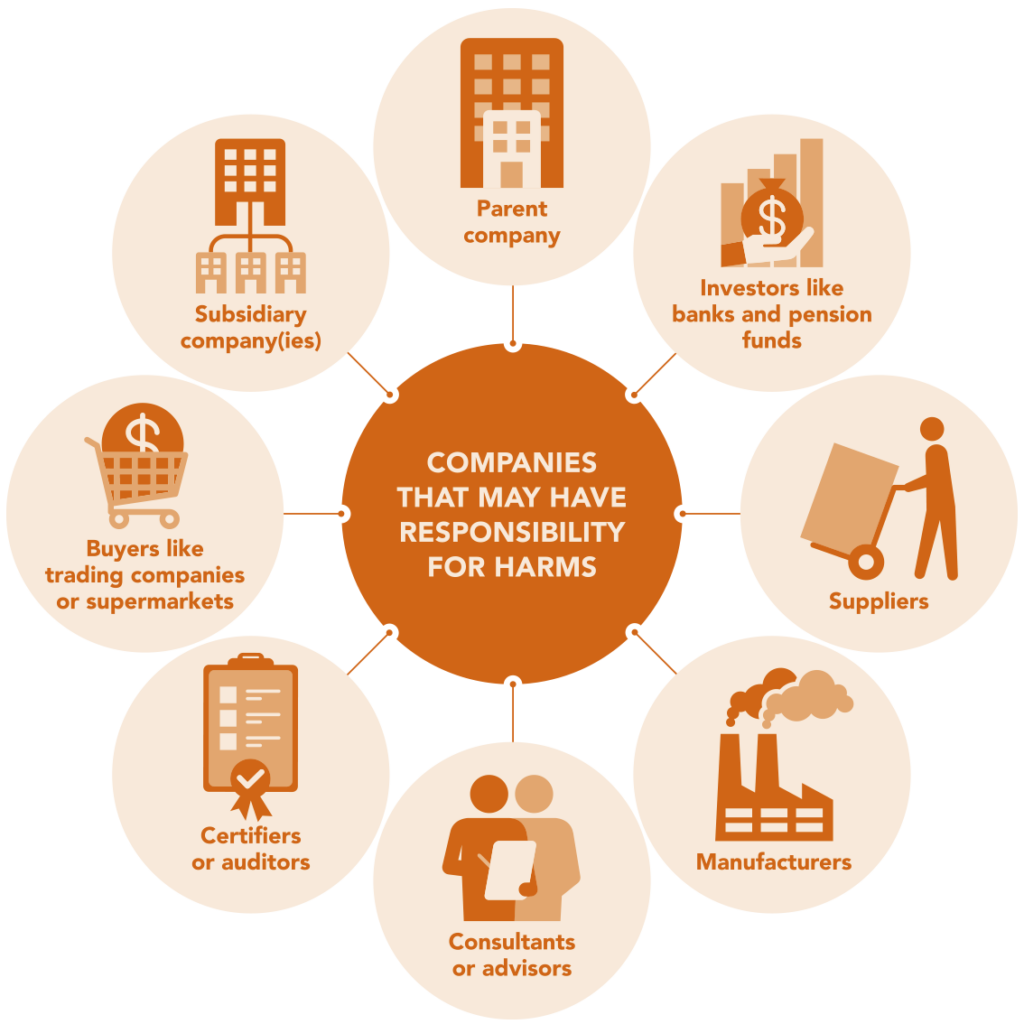Once you have decided to file a National Contact Point (NCP) complaint, follow the steps below to make sure it is as effective as possible in helping you achieve your goals.

Quick jump:
Step 1: Collect evidence about your strongest claims
Step 2: Determine which claims to raise
Step 3: Determine which NCP(s) to file to
Step 4: Consider our tips for strengthening your complaint
Step 5: Write the complaint
Step 6: File the NCP complaint
Step 1: Collect evidence about your strongest claims
Collect evidence and documents – such as witness statements, company policies, scientific tests, and public articles or reports – showing the harm that has occurred or may occur and a connection to a company. The evidence should be credible and plausibly linked to harmful corporate activity, showing that harm is occurring or likely to occur and linked to a company’s failure to meet the standards in the OECD Guidelines.
You should also collect information about the company involved in the harm, including where it is headquartered. Read OECD Watch’s tips below to make your complaint more effective and strategic, and contact us if you need assistance.
Step 2: Determine which claims to raise
Based on the evidence, determine which claims to raise against which company(ies). We recommend you raise only your strongest claims, showing the clearest evidence of a company’s breach of the OECD Guidelines. Filing strong claims on just a few Guidelines provisions is better than including multiple less-substantiated claims.
You can file a complaint against numerous companies if they are all linked to the same underlying situation or harms and fall under an NCP’s jurisdiction.
You may also need to file under the 2011 and/or 2023 versions of the OECD Guidelines. OECD Watch has developed guidance for civil society on which version of the Guidelines to reference in an NCP complaint.
Step 3: Determine which NCP(s) to file to
Based on the claims and the company(ies) you have identified, determine which NCP(s) you will file the complaint to.
Complaints should be filed at the NCP of the country where the issues have arisen. This may be the country where the harm is felt on the ground (the country ‘hosting’ the business activity, called the ‘host country’). This may also or alternatively be the country where the company is headquartered (the ‘home country’), either because the host country does not follow the OECD Guidelines and has no NCP or because the issues actually arose during (poor) decision-making at headquarters level. Sometimes, both the host and home countries have NCPs. Complaints can be filed at both NCPs or just one. NCPs handling complaints related to the same situation will coordinate with each other. Contact OECD Watch if you have questions about which NCP to file to.
Step 4: Consider our tips for strengthening your complaint
Based on our understanding of the limitations of the NCP complaint process and experience advising civil society complainants, we have identified tips for complainants to enhance the effectiveness of their NCP complaint.
- Embed your complaint in a wider strategy for justice: The OECD Guidelines’ standards are voluntary, and National Contact Points cannot require companies to participate in a complaint or remediate harms. This means that an NCP complaint itself may not achieve meaningful change. However, if embedded in a broader strategy, a complaint can achieve remedy or increase attention to the harms among the public, media, governments, and the company’s shareholders or investors to help bring about remedy later.
- Collaborate with other communities and civil society: Collaborating with communities and national and international civil society organisations experiencing or focused on similar issues, harms, companies, sectors, or victim groups can strengthen your expertise and impact in a complaint. Consider co-filing complaints or filing “campaigns” of complaints highlighting a particular issue or theme across different companies and geographies. Contact OECD Watch for help building collaborations.
- File the complaint at the right time to support your wider strategy: Consider public awareness of the situation, media interest, government activity on related issues, or the timelines of other ‘parallel’ complaints.
- Think carefully about the strengths and weaknesses of relevant NCPs: Depending on what companies are involved, the complaint may be admissible at more than one NCP. Some NCPs facilitate more transparency in complaints. Some are willing to issue determinations for company misconduct. Others will proceed with analysis even if a company refuses to participate. Explore OECD Watch’s evaluations of NCP effectiveness to learn about the different NCPs and how they could best support your larger strategy.
- File a complaint towards the companies connected to the harm that best support your wider strategy. Try to identify the company or actor causing the harm. Then, find out all the companies that have a business relationship with that company or actor and may, therefore, be connected to the harm and headquartered in countries that follow the Guidelines. This could be done through your own research, for example, by looking at the company’s website or media articles or with the support of other civil society groups.

All of these actors may have some responsibility for the harm under the OECD Guidelines – see OECD Watch’s guidance for civil society on understanding the different ways that companies can be connected to harm. Consider strategically which companies to target. Factors to consider include the level of the company’s responsibility for the harm; public focus on certain companies or sectors; the company’s reputation for engaging in responsible business conduct issues and complaints; the company’s headquarters location; and related opportunities for media and government attention. Reach out to OECD Watch if you need help understanding and researching the different actors that might be connected to the harms you are facing.
- Consider filing a complaint to advance national law or global standards: Because the scope of the Guidelines is often broader than national law, an NCP complaint can highlight and advocate closure of gaps in national law. The Guidelines also outline responsibility for companies all the way up and down the value chain, advancing global responsible business conduct standards.
Step 5: Write the complaint
Follow all of our tips for filing strong complaints. OECD Watch has also developed a template for complainants to structure their complaints (also available in French and Spanish).
Note on language: Complaints can be written, and evidence can be provided to the NCP in your own language if that is easiest for you. Keep in mind, however, that the NCP may not accept the complaint in any language, may not be willing to translate (all) documents, and that not translating the complaint could result in additional delays. If possible, writing the complaint in English or a national language of the NCP receiving the case can help ensure the complaint is heard. Contact the NCP to clarify whether they will accept a complaint in your language of choice. Also, contact us if you are facing difficulty with language barriers.
Step 6: File the NCP complaint
File the complaint according to any particular processes required by the relevant NCP(s). Some NCPs have specific requirements on what information must be included in a complaint or how information should be presented. Be sure to check the NCP(s) website to which you will file your complaint to ensure you meet their requirements. It is also important to consider the NCP’s requirements on confidentiality when filing complaints.

